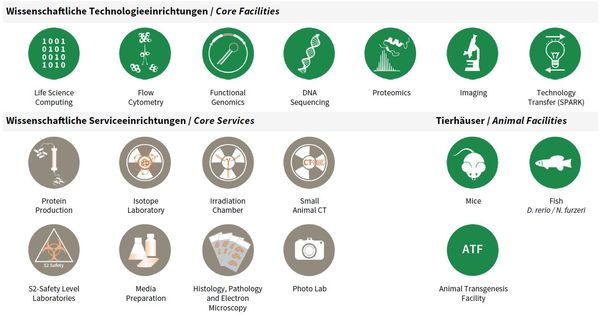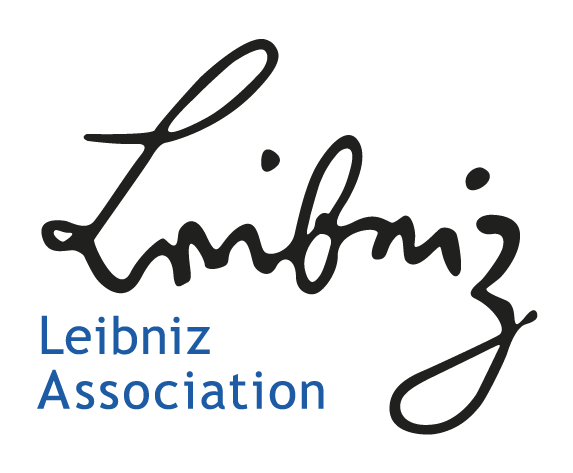Core Facilites and Core Services
At the beginning of 2016, a “core” structure was put into effect that organized facility and service units as independent organizational entities from FLI’s research groups. A number of technology platforms (e.g. sequencing, mass spectrometry) grew out of individual methodological requirements for single research groups in the last years but developed into semiautonomous substructures. As consequence of re-focused research activities and the concomitant advent of new research groups at FLI, those units increasingly had to serve many FLI groups and collaborative research efforts in the Jena research area.
To accommodate this development and to increase efficiency as well as transparency for users, facility personnel and for administrative processes, it came natural to re-organize such activities into independent units as “FLI Core Facilities and Services” and to phase out infrastructures considered non-essential for FLI’s research focus (X-ray crystallography and NMR spectroscopy).
FLI’s Core Facilities (CF) are managed by a CF Manager and are each scientifically guided in their activities and development by an FLI Group Leader, as Scientific Supervisor. The animal facilities comprising fish, mouse and transgenesis are run separately, as they involve a more complex organizational structure. Basic Core Services (CS) are directly led by the Head of Core (HC), who in turn is supported by individual CS Managers.
All facilities and services, including animal facilities, have a valuable contribution to FLI’s research articles; e.g. from 2016–2018, to 54% of all peer reviewed research publications.
Overview Core Facilities and Core Services at FLI.
Publications
(since 2016)
2020
- Modulation of FLT3 signal transduction through cytoplasmic cysteine residues indicates the potential for redox regulation.
Böhmer A, Barz S, Schwab K, Kolbe U, Gabel A, Kirkpatrick J, Ohlenschläger O, Görlach M, Böhmer FD
Redox Biol 2020, 28, 101325 - Spatially resolved analysis of FFPE tissue proteomes by quantitative mass spectrometry.
Buczak K, Kirkpatrick JM, Truckenmueller F, Santinha D, Ferreira L, Roessler S, Singer S, Beck** M, Ori** A
Nat Protoc 2020, 15(9), 2956-79 ** co-corresponding authors - Structure of an RNA aptamer in complex with the fluorophore tetramethylrhodamine.
Duchardt-Ferner E, Juen M, Bourgeois B, Madl T, Kreutz C, Ohlenschläger O, Wöhnert J
Nucleic Acids Res 2020, 48(2), 949-61 - Loss of metabolic plasticity underlies metformin toxicity in aged Caenorhabditis elegans.
Espada* L, Dakhovnik* A, Chaudhari* P, Martirosyan A, Miek L, Poliezhaieva T, Schaub Y, Nair A, Döring N, Rahnis N, Werz O, Koeberle A, Kirkpatrick J, Ori A, Ermolaeva MA
Nat Metab 2020, 2(11), 1316-31 * equal contribution - Structural insights into the main S-layer unit of Deinococcus radiodurans reveal a massive protein complex with porin-like features.
Farci D, Aksoyoglu MA, Farci SF, Bafna JA, Bodrenko I, Ceccarelli M, Kirkpatrick J, Winterhalter M, Kereïche S, Piano D
J Biol Chem 2020, 295(13), 4224-36 - Region-Specific Proteome Changes of the Intestinal Epithelium during Aging and Dietary Restriction.
Gebert N, Cheng CW, Kirkpatrick JM, Di Fraia D, Yun J, Schädel P, Pace S, Garside GB, Werz O, Rudolph KL, Jasper H, Yilmaz ÖH, Ori A
Cell Rep 2020, 31(4), 107565 - miR-182-5p is an evolutionarily conserved Tbx5 effector that impacts cardiac development and electrical activity in zebrafish.
Guzzolino E, Pellegrino M, Ahuja N, Garrity D, D'Aurizio R, Groth M, Baumgart M, Hatcher CJ, Mercatanti A, Evangelista M, Ippolito C, Tognoni E, Fukuda R, Lionetti V, Pellegrini M, Cremisi F, Pitto L
Cell Mol Life Sci 2020, 77(16), 3215-29 - Correction: The acetyltransferase GCN5 maintains ATRA-resistance in non-APL AML.
Kahl M, Brioli A, Bens M, Perner F, Kresinsky A, Schnetzke U, Hinze A, Sbirkov Y, Stengel S, Simonetti G, Martinelli G, Petrie K, Zelent A, Böhmer FD, Groth M, Ernst T, Heidel FH, Scholl S, Hochhaus A, Schenk T
Leukemia 2020, 34(7), 1972 - Reduced proteasome activity in the aging brain results in ribosome stoichiometry loss and aggregation.
Kelmer Sacramento* E, Kirkpatrick* JM, Mazzetto* M, Baumgart M, Bartolome A, Di Sanzo S, Caterino C, Sanguanini M, Papaevgeniou N, Lefaki M, Childs D, Bagnoli S, Terzibasi Tozzini E, Di Fraia D, Romanov N, Sudmant PH, Huber W, Chondrogianni N, Vendruscolo M, Cellerino** A, Ori** A
Mol Syst Biol 2020, 16(6), e9596 * equal contribution, ** co-corresponding authors - A Caenorhabditis elegans ortholog of human selenium-binding protein 1 is a pro-aging factor protecting against selenite toxicity.
Köhnlein* K, Urban* N, Guerrero-Gómez D, Steinbrenner H, Urbánek P, Priebs J, Koch P, Kaether C, Miranda-Vizuete A, Klotz LO
Redox Biol 2020, 28, 101323 * equal contribution









